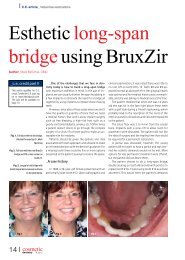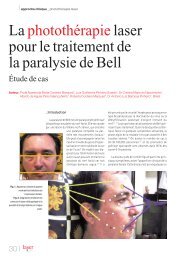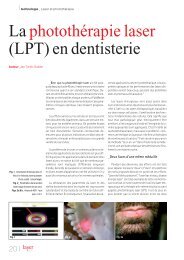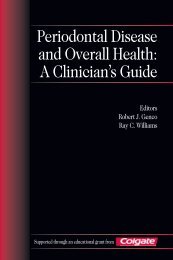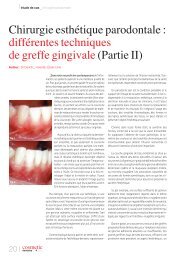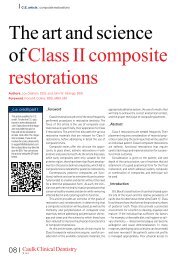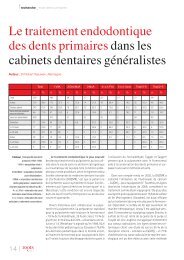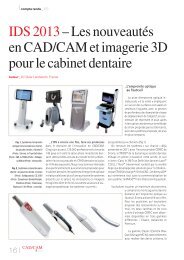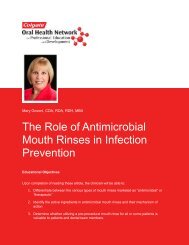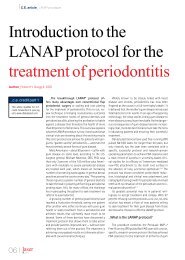Periodontal Disease and Overall Health: A Clinician's Guide
Periodontal Disease and Overall Health: A Clinician's Guide
Periodontal Disease and Overall Health: A Clinician's Guide
Create successful ePaper yourself
Turn your PDF publications into a flip-book with our unique Google optimized e-Paper software.
CHAPTER 2 Overview of <strong>Periodontal</strong> <strong>Disease</strong>:CHAPTER 2 Causes, Pathogenesis, <strong>and</strong> Characteristics 13the host immuno-inflammatory response toplaque bacteria produces destructive cytokines<strong>and</strong> enzymes resulting in periodontaltissue destruction. The host response is essentiallyprotective by intent but can alsoresult in tissue damage, including the breakdownof connective tissue fibers in the periodontalligament <strong>and</strong> the resorption of alveolarbone. The host response to the plaquebiofilm is modified by genetic factors (helpingto explain why aggressive periodontitistends to have a familial aggregation), as wellas systemic <strong>and</strong> environmental factors (e.g.,diabetes, stress, smoking).To better treat <strong>and</strong> manage periodontaldiseases, we need a more detailed underst<strong>and</strong>ingof periodontal pathogenesis (Figure1). 35-37 The bacteria <strong>and</strong> their metabolic products(e.g., endotoxin) stimulate the junctionalepithelium to proliferate, <strong>and</strong> to produce tissue-destructiveproteinases. This infectionalso increases the permeability of the junctionalepithelium that allows microbes <strong>and</strong>their products to gain access to the subepithelialconnective tissue. Epithelial <strong>and</strong> connectivetissue cells are thus stimulated toproduce inflammatory mediators that resultin an inflammatory response within the tissues.Microbial products also chemotacticallyattract a constant flux of pro-inflamma -tory cells migrating from the circulation tothe gingival crevice. Neutrophils, or PMNLs,are predominant in the early stages of gingivalinflammation. Thus, an immune responseis generated in the periodontal tissues <strong>and</strong>pro-inflammatory cytokines such as IL-1β,TNF-α, <strong>and</strong> MMPs are produced by inflammatorycells recruited to the lesion site. Thefunctions of PMNLs include phagocytosis<strong>and</strong> destruction of bacteria. Initially the clinicalsigns of gingivitis are evident. This responseis essentially protective in nature toFigure 1. Schematic Illustration of the Pathogenesis of PeriodontitisGenetic risk factorsMicrobialchallengeAntibodyPMNsAntigensLPSOthervirulencefactorsHostimmuneinflammatoryresponseCytokinesProstanoidsMMPsConnectivetissue <strong>and</strong>bonemetabolismClinicalsigns ofdiseaseEnvironmental <strong>and</strong> acquiredrisk factorsTissue breakdown products <strong>and</strong> ecological changesCopyright 2006 by Saunders, an imprint of Elsevier Inc.Source: Carranza’s Clinical Periodontology, 10th Ed. WB Saunders Company; 2006:275–282. 36 Reproducedwith permission.



